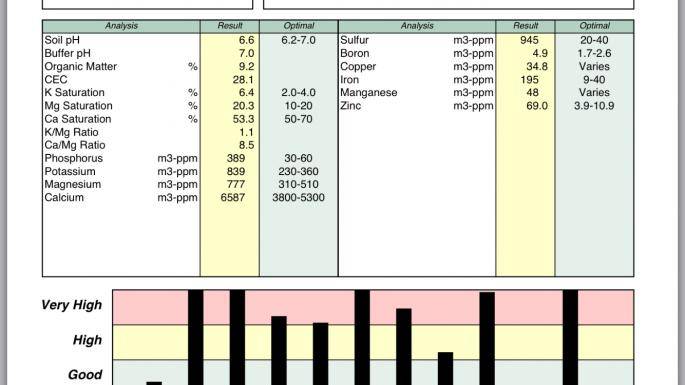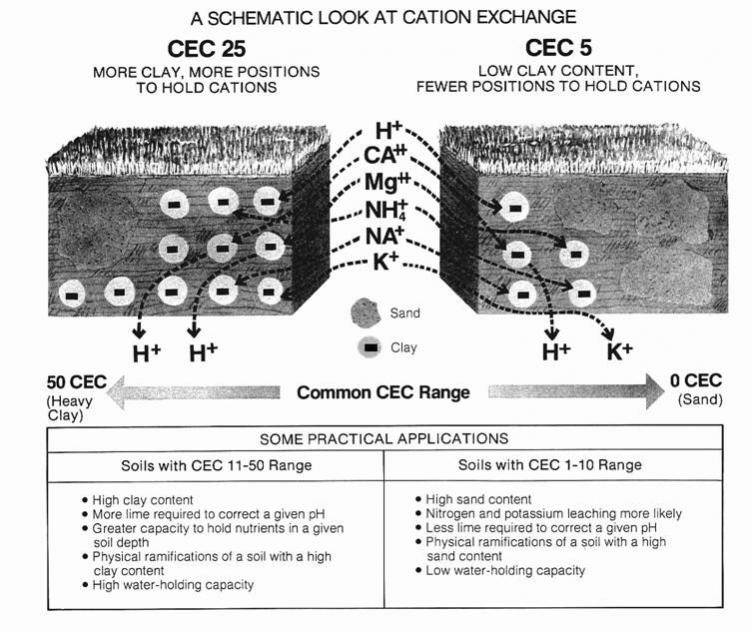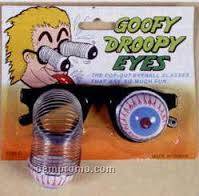Lightweight Peat's Mucky Muck soil testing
- Thread starter Thread starter biggreg
- Start date Start date
biggreg
Member
I came to this forum for guidance and answers. It's a sad state of things if I'm providing that to you.
I will get a satisfactory soil test done to existing written standards reported in relevant units. Y'all can count on that. I was hoping someone else would have blazed this path and shared the info.
Don't be stingy with your knowledge. A rising tide lifts all boats.
I will get a satisfactory soil test done to existing written standards reported in relevant units. Y'all can count on that. I was hoping someone else would have blazed this path and shared the info.
Don't be stingy with your knowledge. A rising tide lifts all boats.
Last edited:
biggreg
Member
Think about what your soil test is telling you.
Think about the milligrams of element per kilogram of air dried soil. What does that number tell you?
Look at the cation ratios on your report. If you're into ideal soil, Albrecht, intelligent Gardner type stuff, the method used to calculate your CEC is important if you want to be on the same page as those guys. Check the math used by these lab types.

This was from the test i paid extra for a proper weigh in. Turned out this was really a 1g / 10ml test. I refused it and demanded a retest at the industry standard of 2g /20ml.
Right away I noticed the CEC. Hmm, that ain't the math bro. Add it up.
This test adds up to 46.59 meq/100g using the "brookside method" the Ca - Mg- K ratio is 70-14-4.6 using the method of the ideal soil guys. https://growabundant.com/calculate-tcec/
How do they get their number? By using an arbitrary in house, not published on their site "rule" of not counting anymore than 3000ppm Ca towards the CEC. WHY? Because if farmer John sends in his mineral soil and it reads more than 3000ppm, it's a good practical bet that farmer johns acerage was recently limed. The ratios reported on this test are off big time because of that hidden "rule" designed for mineral soils.
If a fella were to try and use these ratios as calculated, the only way to hit 68, 75 or 85% Ca ( whatever your target is) would be to wash out some mg and K with gypsum because the lab refuses to count more than 3000ppm Ca, The ratios reported by this lab are screwed for high CEC, lightweight density soils. So wrong it's rediculious. Do your own math. Do not use spectrums math on your base cation ratios. Their math will send you into la la land with your lightweight density soils.
Think about the milligrams of element per kilogram of air dried soil. What does that number tell you?
Look at the cation ratios on your report. If you're into ideal soil, Albrecht, intelligent Gardner type stuff, the method used to calculate your CEC is important if you want to be on the same page as those guys. Check the math used by these lab types.
This was from the test i paid extra for a proper weigh in. Turned out this was really a 1g / 10ml test. I refused it and demanded a retest at the industry standard of 2g /20ml.
Right away I noticed the CEC. Hmm, that ain't the math bro. Add it up.
This test adds up to 46.59 meq/100g using the "brookside method" the Ca - Mg- K ratio is 70-14-4.6 using the method of the ideal soil guys. https://growabundant.com/calculate-tcec/
How do they get their number? By using an arbitrary in house, not published on their site "rule" of not counting anymore than 3000ppm Ca towards the CEC. WHY? Because if farmer John sends in his mineral soil and it reads more than 3000ppm, it's a good practical bet that farmer johns acerage was recently limed. The ratios reported on this test are off big time because of that hidden "rule" designed for mineral soils.
If a fella were to try and use these ratios as calculated, the only way to hit 68, 75 or 85% Ca ( whatever your target is) would be to wash out some mg and K with gypsum because the lab refuses to count more than 3000ppm Ca, The ratios reported by this lab are screwed for high CEC, lightweight density soils. So wrong it's rediculious. Do your own math. Do not use spectrums math on your base cation ratios. Their math will send you into la la land with your lightweight density soils.
Last edited:
biggreg
Member
I'm not preaching ideal soil, Albriect, BCSR, tiedjens, SLAN, Reams, or any particular mainstream or fringe methodology for interpreting soil tests. I'm just preaching proper handling, testing and relevant units so we can actually try out for ourselves every method.
That is an advantage us container growers have over the land locked farmers, we ( in theory) have more complete control of our soil. We can whip up a desert media for our catus, a tropical peat for our cannabis or whatever we want, quickly. We grow in smaller volumes so we can afford to play around with optimum levels without as large of an economic concern as the land attached. Takes the outdoor guy years and years to achieve a balance that we can do in few months. We don't have to commit. We may only mix up 100L ( I'm ditching gallons as a form of social protest) at a time. Gives us freedom to explore, test out and compare the differing systems of nutrient management according to soil tests.
With accurate testing and relevant units, we could whip up a diffrent style in every container. Sorta like pheno hunting and keeping clones, find your soil that works for your strain/conditions and have detailed records and soil tests on it. That's your clone. Reproduce your winning soil over and over.
Find your own critical levels of each element. Find the toxic level too.
If we want to tinker with this stuff, we need the right tools.
That is an advantage us container growers have over the land locked farmers, we ( in theory) have more complete control of our soil. We can whip up a desert media for our catus, a tropical peat for our cannabis or whatever we want, quickly. We grow in smaller volumes so we can afford to play around with optimum levels without as large of an economic concern as the land attached. Takes the outdoor guy years and years to achieve a balance that we can do in few months. We don't have to commit. We may only mix up 100L ( I'm ditching gallons as a form of social protest) at a time. Gives us freedom to explore, test out and compare the differing systems of nutrient management according to soil tests.
With accurate testing and relevant units, we could whip up a diffrent style in every container. Sorta like pheno hunting and keeping clones, find your soil that works for your strain/conditions and have detailed records and soil tests on it. That's your clone. Reproduce your winning soil over and over.
Find your own critical levels of each element. Find the toxic level too.
If we want to tinker with this stuff, we need the right tools.
Last edited:
biggreg
Member
I want us to be finding and measuring what works.
Can't do that with bunk basto-"tests" of shame. If these labs would just stop and think about what they are signing their reputation to, maybe we would start to see some changes. ( assuming the lab has any pride in their work at all)
Can't do that with bunk basto-"tests" of shame. If these labs would just stop and think about what they are signing their reputation to, maybe we would start to see some changes. ( assuming the lab has any pride in their work at all)
biggreg
Member
Let's list the growers affected by the big soil labs not having a lightweight soil protocol:
Organic soil container gardeners
Organic-mineral soil container gardeners.
Raised bed land locked gardeners
High organic matter gardeners
Greenhouse vegetable gardeners
High tunnels
Muck farmers
Tropical peat farms
Tundra farms
Everglades Ag area
Michigan mucks
New York mucks
Northern Europe peatlands
North Carolina blacklands
And even Well cultivated backyard mineral soil gardens
All of these growers are growing in soil less dense than 1g/cm3. Our numbers are smaller than "standard" growers but we do exist in numbers.
Anyone who is less than 1g/cm3 is a lightweight. Lightweights need a proper mass measured into the test and a proper bulk density taken. Elements should be reported in volumetric ppm.
Lightweights deserve a soil test too, why should our test be less accurate than a soil test that happens to be close to standard density?
Organic soil container gardeners
Organic-mineral soil container gardeners.
Raised bed land locked gardeners
High organic matter gardeners
Greenhouse vegetable gardeners
High tunnels
Muck farmers
Tropical peat farms
Tundra farms
Everglades Ag area
Michigan mucks
New York mucks
Northern Europe peatlands
North Carolina blacklands
And even Well cultivated backyard mineral soil gardens
All of these growers are growing in soil less dense than 1g/cm3. Our numbers are smaller than "standard" growers but we do exist in numbers.
Anyone who is less than 1g/cm3 is a lightweight. Lightweights need a proper mass measured into the test and a proper bulk density taken. Elements should be reported in volumetric ppm.
Lightweights deserve a soil test too, why should our test be less accurate than a soil test that happens to be close to standard density?
Last edited:
Think about what your soil test is telling you.
Think about the milligrams of element per kilogram of air dried soil. What does that number tell you?
Look at the cation ratios on your report. If you're into ideal soil, Albrecht, intelligent Gardner type stuff, the method used to calculate your CEC is important if you want to be on the same page as those guys. Check the math used by these lab types.
[URL=https://www.icmag.com/ic/picture.php?albumid=70606&pictureid=1689320&thumb=1]View Image[/url]
This was from the test i paid extra for a proper weigh in. Turned out this was really a 1g / 10ml test. I refused it and demanded a retest at the industry standard of 2g /20ml.
Right away I noticed the CEC. Hmm, that ain't the math bro. Add it up.
This test adds up to 46.59 meq/100g using the "brookside method" the Ca - Mg- K ratio is 70-14-4.6 using the method of the ideal soil guys. https://growabundant.com/calculate-tcec/
How do they get their number? By using an arbitrary in house, not published on their site "rule" of not counting anymore than 3000ppm Ca towards the CEC. WHY? Because if farmer John sends in his mineral soil and it reads more than 3000ppm, it's a good practical bet that farmer johns acerage was recently limed. The ratios reported on this test are off big time because of that hidden "rule" designed for mineral soils.
If a fella were to try and use these ratios as calculated, the only way to hit 68, 75 or 85% Ca ( whatever your target is) would be to wash out some mg and K with gypsum because the lab refuses to count more than 3000ppm Ca, The ratios reported by this lab are screwed for high CEC, lightweight density soils. So wrong it's rediculious. Do your own math. Do not use spectrums math on your base cation ratios. Their math will send you into la la land with your lightweight density soils.
lol...that report format looks familiar...where have I seen it....

biggreg
Member
Soils come in a wide ranging Spectrum of exchange capacities.
These are usually expressed in meq/100g or cmoles/kg. This per mass expression of the capacity is a relevant unit of measure on "standard" density soil.

In lighter weight soils, the relevant unit becomes meq/100cm3 or cmoles/dm3
Plants grow in a volume of field moist soil, not an air dried mass of soil.
Multiply your meq/100g x bulk density g/100cm3 to get your meq/100cm3. This unit measures the exchange capacity of your volume of soil. Your container garden is volumes of soils, not the mass of air dried. The CEC per mass can be deceptive if the soil is anything other than 1g/cm3.
Where does your soil fall on the CEC Spectrum?
These are usually expressed in meq/100g or cmoles/kg. This per mass expression of the capacity is a relevant unit of measure on "standard" density soil.
In lighter weight soils, the relevant unit becomes meq/100cm3 or cmoles/dm3
Plants grow in a volume of field moist soil, not an air dried mass of soil.
Multiply your meq/100g x bulk density g/100cm3 to get your meq/100cm3. This unit measures the exchange capacity of your volume of soil. Your container garden is volumes of soils, not the mass of air dried. The CEC per mass can be deceptive if the soil is anything other than 1g/cm3.
Where does your soil fall on the CEC Spectrum?
biggreg
Member
Okay, we looked at the CEC Spectrum, let's get Analytic and look the test posted above again.
Take the 6587mg/kg Ca number. multiply it by the bulk density of .363g/cm3 = 2391 mg/dm3, well below their secret warning level of 3000ppm mg/kg for mineral soil or 3000ppm mg/dm3 for mineral soil ( mineral soil is assumed to be 1kg/dm3 by the lab. Both per mass ppm and per volume ppm are the same in "standard" mineral soil).
Take the 6587mg/kg Ca number. multiply it by the bulk density of .363g/cm3 = 2391 mg/dm3, well below their secret warning level of 3000ppm mg/kg for mineral soil or 3000ppm mg/dm3 for mineral soil ( mineral soil is assumed to be 1kg/dm3 by the lab. Both per mass ppm and per volume ppm are the same in "standard" mineral soil).
Last edited:
biggreg
Member
Thought experiment:
What would happen to the test results per mass ( mg/kg and meq/100g) if in this mix, the heavy sand was replaced with the same volume of perlite?. Imagine the soil had the same everything per volume, just the inert heavy sand replaced with inert light perlite.
What would happen to the ppm-mass/mass (mg/kg) of the reported elements and the reported CEC /mass (meq/100g)? Would reported values go up or down?
What would happen to the test results per mass ( mg/kg and meq/100g) if in this mix, the heavy sand was replaced with the same volume of perlite?. Imagine the soil had the same everything per volume, just the inert heavy sand replaced with inert light perlite.
What would happen to the ppm-mass/mass (mg/kg) of the reported elements and the reported CEC /mass (meq/100g)? Would reported values go up or down?
Last edited:
biggreg
Member
Let's assume :
You're working with 100L ( 26.4g) soil per container. One is the Perlite mix and the other is the sand.
Both mixes are equal volumes
Both have equal volumes of identical peats and composts
Both mixes have equal amounts of dry amendments weighed in per container
And let's assume:
Perlite or sand contribute no Mehlich 3 extractable elements
Perlite and sand have no cation exchange capacity.
The only difference between the two containers of soil for the purpose of our test is is the final weight when filled,
So you have these containers all mixed up, send in two samples for a Mehlich 3, what would you expect to see when the results come back?
You're working with 100L ( 26.4g) soil per container. One is the Perlite mix and the other is the sand.
Both mixes are equal volumes
Both have equal volumes of identical peats and composts
Both mixes have equal amounts of dry amendments weighed in per container
And let's assume:
Perlite or sand contribute no Mehlich 3 extractable elements
Perlite and sand have no cation exchange capacity.
The only difference between the two containers of soil for the purpose of our test is is the final weight when filled,
So you have these containers all mixed up, send in two samples for a Mehlich 3, what would you expect to see when the results come back?
biggreg
Member
Work that math and you will also come to the conclusion that:
1. Extractable elemental mass per mass of air dried soil
And
2. Cation exchange capacity in meq per 100 grams of air dried soil
Are not the relevant units to measure lightweight soil.
Those units are only useful in "standard" mineral soil because they roughly equal the actual relevant measuring units of mg/dm3 and meq/100cm3
Ol' Man Mehlich tried to get everyone to see this back in the 70's. He Learned quick when his lab that offered free soil tests for North Carolina residents was bombarded with organic lightweight and sandy heavyweight soil samples . He had to adapt.
In the other states with their mostly "standard" soil, soil labs declined implementing the extra steps needed to report in relevant units.
1. Extractable elemental mass per mass of air dried soil
And
2. Cation exchange capacity in meq per 100 grams of air dried soil
Are not the relevant units to measure lightweight soil.
Those units are only useful in "standard" mineral soil because they roughly equal the actual relevant measuring units of mg/dm3 and meq/100cm3
Ol' Man Mehlich tried to get everyone to see this back in the 70's. He Learned quick when his lab that offered free soil tests for North Carolina residents was bombarded with organic lightweight and sandy heavyweight soil samples . He had to adapt.
In the other states with their mostly "standard" soil, soil labs declined implementing the extra steps needed to report in relevant units.
biggreg
Member
Why would one pay for a broken test that only measures base ratios and the rest of the report is non-sensical false numbers that should not be taken at face value and should be ignored unless all you care about is seeing ratios and trends when the test, if done to standard, will give base ratios and real numbers for the mass of extractable elements per mass of air dried soil?
And then,
Why would you only want to look at the mass of your elements per mass of air dried soil when you could be looking at the mass of your elements per volume of your container?
And then,
Why would you only want to look at the mass of your elements per mass of air dried soil when you could be looking at the mass of your elements per volume of your container?
biggreg
Member
These tests are only tools. The chemical makeup of your soil is a part of growing. Use a tool that actually measures what it was designed to measure.
Let me break it down:
For lightweight soils,
Weighing sample with a Scoop bad
Using 1/2 the standard sample size bad
Assuming density bad
Weighing with a balance good
Using standard amount of soil to solution good
Measured Bulk density good
Reports in mg/dm3 good
CEC in meq/100cm3 good.
Its your choice, it's up to you to decide the best tool to look into your soil with.
Either the fun-house mirror, basto-version of some non standard bullshit of a soil extraction experiment gone wrong ( what you're been sold up to now)

Or
A by the book test done to established standards and reported in relevant units?

Let me break it down:
For lightweight soils,
Weighing sample with a Scoop bad
Using 1/2 the standard sample size bad
Assuming density bad
Weighing with a balance good
Using standard amount of soil to solution good
Measured Bulk density good
Reports in mg/dm3 good
CEC in meq/100cm3 good.
Its your choice, it's up to you to decide the best tool to look into your soil with.
Either the fun-house mirror, basto-version of some non standard bullshit of a soil extraction experiment gone wrong ( what you're been sold up to now)
Or
A by the book test done to established standards and reported in relevant units?
biggreg
Member
How would all you "standard" mineral soil, land locked farmers like it if the lab quit using a standard scoop that closely approximates the correct mass for your type of soil and just decided to eyeball the measurement? What if everyone who farmed in standard soil were told to just ignore the pounds per acre numbers and the low, adequate and high levels portrayed on the chart? What if the lab used a different soil to solution ratio on every test? Wouldn't that be awesome?
Last edited:
biggreg
Member
Maybe a "pinch" of soil could be our new standard? Shit, we could revolutionize argonomy! Forget everything we've been doing up to this point. A "pinch" of soil to a splash of extractant. We would still see the ratios of the major elements, who cares about micros? Who cares about actual soil levels and bulk density, let's all amend like its 1g/cm3 no matter what. It's close enough. All this fancy argonomy is dumb.
Latest posts
-
ICMag Poll: Let's see which age group is most active on the forum!
- Latest: Gypsy Nirvana
-
-
-
-
Latest posts
-
ICMag Poll: Let's see which age group is most active on the forum!
- Latest: Gypsy Nirvana
-
-
-
-


